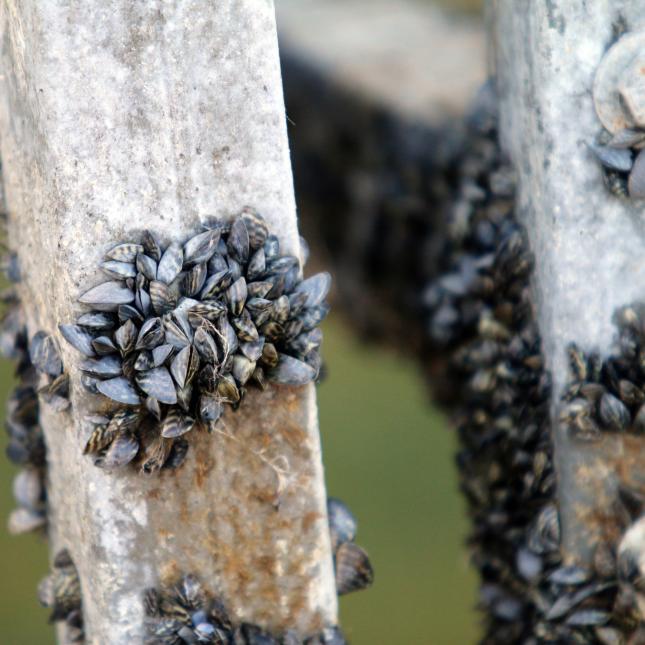An imminent threat
Where introduced, freshwater zebra mussels change native ecosystems, threatening native fish and wildlife species and habitats. Often introduced along with their close relative, quagga mussels, they can clog water intake pipes impacting critical infrastructure necessary for hydroelectric power systems, irrigated agriculture, drinking water, and sewage costing utilities, companies, and taxpayers millions of dollars in mitigation and management costs. Zebra mussels are not currently known to be established in Washington, but the risk that they will be introduced to our waters is significant.
Fortunately, introduction is preventable. Overland transportation of quagga mussels on aquatic gear, equipment, and watercraft, a common introduction pathway into new waterbodies, can be avoided by practicing Clean, Drain, Dry and decontaminating equipment used in waters that may be infested. Proper disposal of aquarium plants and animals can also prevent introduction. Zebra mussels have been found attached to imported Marimo moss balls sold at Washington retail pet and aquarium stores.
More information on how to prevent the introduction and spread of zebra mussels and other aquatic invasive species (AIS) can be found on the AIS prevention webpage.
Invasive species information
Invasive characteristics
Byssal threads allow adult zebra mussels to hitch a ride on any solid surface, including aquatic plants, watercraft, aquatic equipment, and gear. Once attached, they can survive out of the water for up to a month in cool, damp conditions.
Microscopic larvae can be transported in anything that holds water including bilges, live wells, motor cooling systems and other water systems.
Free from predators and conditions that restrict their growth and spread in their native range, zebra mussels attach to all available surfaces, forming dense carpets that smother native species leading to habitat loss. Loss of aquatic plants leads to increased water transparency, increasing water temperature and encourages aquatic weed growth. Loss of habitat leads to declines in native species populations.
Zebra mussels bioaccumulate pollutants and toxins. Animals that eat the mussels then spread toxins through the food chain to animals that eat them, eventually making fish and wildlife unsafe for human consumption. They also lead to increases in botulism causing bacteria, a serious neurotoxin and risk to human health.
Prevention
Once introduced to freshwater bodies in the U.S., zebra mussels have proven nearly impossible to eradicate. The best way to avoid the catastrophic threats posed by zebra mussels is to prevent them from establishing in Washington’s waters.
While WDFW monitors waterbodies statewide each year for zebra mussels and prepares to address a potential detection, anyone who recreates or works on Washington’s waters can help prevent invasive mussels from reaching our waters.
Overland transportation of invasive mussels on contaminated gear, equipment, and watercraft is preventable by remembering to Clean, Drain, Dry and stopping at all mandatory watercraft inspection stations. Prevent contaminated aquarium plants from introducing invasive mussels to our waters by properly disposing of them.
If you suspect your gear, equipment, watercraft, or aquarium plants may be carrying zebra mussels, take a photo and report it online using the Washington Invasives online reporting form or download the app. More information on preventing the spread of aquatic invasive species like zebra mussels can be found on the prevention webpage.
Description and Range
Zebra mussels are often found with their close relative, quagga mussels.
Physical description
A freshwater mussel, adult zebra mussels range from 1/8 of an inch to 2 inches but are most commonly 1 inch or less. Zebra mussels are much smaller than native freshwater mussels, most of which measure around 5 inches.
Zebra mussel shells are D-shaped and mostly white to cream-colored with jagged brown or black stripes across the shell.
Ecology and life history
Zebra mussel larvae are microscopic and free-floating, using water currents to carry them to new areas to infest. As they age, the larvae gain the ability to swim, eventually settling as juveniles and anchoring themselves to a solid surface with their byssal threads. They mature in the first or second year and female mussels can produce millions of eggs per year.
Geographic range
Native to the Caspian Sea, zebra mussels were first detected in the Great Lakes in 1988. Believed to have been introduced to the U.S. in the ballast water of trans-oceanic ships, they have since spread throughout the U.S. and Canada but have not yet been found in Washington.
Regulations
Rules and seasons
Zebra mussels are not known to be established in Washington and are a prohibited level 1 species that may not be possessed, imported, purchased, sold, propagated, transported, or released into state waters without department authorization, a permit, or as otherwise provided by rule (RCW 77.15.253).
Prevent transportation of AIS, including invasive mussels, by practicing Clean, Drain, Dry and stopping at all mandatory watercraft inspection stations. Transportation of AIS carries a fine of up to $5,000 and up to a year in jail (RCW 77.135.010).
Resources
General information
Presentations, videos, and webinar recordings
View our Quagga and zebra mussel YouTube playlist for all recordings.
- Invasive Mussel Management | 2025 DFW Lunch and Learn Webinar
- 2024 State of Washington aquatic invasive species quagga and zebra mussel prevention and readiness summit
- 2019 Lake Roosevelt invasive mussel rapid response exercise
- Quagga and zebra mussels - what are they and where did they come from?
- Invasive freshwater mussels & the Columbia River Basin Fish and Wildlife Program | February 27, 2025
- Invasive freshwater quagga and zebra mussel webinar | February 27, 2024









